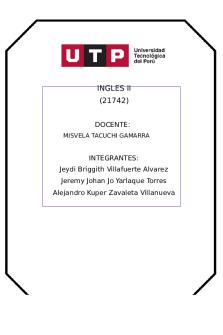Week 6 DD - Fluids - Week 6 Dig Deeper Assignment - Fundamentals of Nursing PDF

| Title | Week 6 DD - Fluids - Week 6 Dig Deeper Assignment - Fundamentals of Nursing |
|---|---|
| Course | Nursing Fundamentals |
| Institution | West Coast University |
| Pages | 2 |
| File Size | 65.3 KB |
| File Type | |
| Total Downloads | 93 |
| Total Views | 126 |
Summary
Week 6 Dig Deeper Assignment - Fundamentals of Nursing...
Description
NURS 100 – Week 6 Dig Deeper Assignment Case Studies, Chapter 39, Fluid, Electrolyte, and Acid-Base Balance 1. You are a nurse who frequently cares for postsurgical patients in your hospital unit. Most of the medical–surgical patients have IV fluids infusing during their admission. Due to the frequent use of IV fluids on your floor, understanding fluid balance and electrolyte function is primary to your nursing practice. (Learning Objectives #1, #6, & #7) a. What conditions might lead to the development of hypovolemia? Blood or body fluid loss can cause hypovolemia and if persistent or severe, diarrhea and vomiting can deplete body fluids. b. How would the amount of patient fluid loss be determined? Measuring the weight of the patient on a daily basis can determine the amount of fluid loss from the patient. c. Describe how hypovolemia and third-space fluid shift correlate. The 3rd space fluid shift would create a fluid loss in a sense because now the fluid moved into spaces that are not available causing low blood volume which is hypovolemia. d. Outline the major difference between hypovolemia and third-space fluid shift. Hypovolemia is the general loss of blood volume and would see a change in weight. The third-space fluid shift will not see a weight change. e. Which conditions can result in third-space fluid shift? Conditions can result in third-space fluid shift includes a disruption in the colloid osmotic pressure, renal dysfunction, heart failure, and hyponatremia. 2. You are a nurse in a nonsurgical cardiac unit caring for a 92-year-old patient who has two sons, 15 grandchildren, and 49 great-grandchildren. She lives in assisted living and has a history of congestive heart failure (CHF). She consistently struggles with balancing her fluids and electrolytes and has an affinity for dill pickles and sauerkraut. While hospitalized, she remains on a fluid restriction—much to her chagrin, as she loves ice cream. (Learning Objectives #2, #7, & #8) a. What within her history would indicate she was at risk for hypervolemia? As the patient has a history of congestive heart failure, she is at significant risk of hypervolemia due to her decreased cardiac output.
NURS 100 – Week 6 Dig Deeper Assignment b. How would dill pickles and sauerkraut impact her fluid volume? Dill pickles and sauerkraut are foods that are very high in sodium, which could cause hypernatremia, resulting in increased fluid retention c. What body areas offer observational evidence of excessive interstitial extracellular fluid (ECF)? Fingers, ankles and feet will be areas of observational evidence of ECF. d. Why would your patient be on a strict fluid restriction while hospitalized? Patient is on a strict fluid restriction while hospitalized because the goal is not add more fluids for the patient. e. Outline nursing interventions used while a patient is on fluid restriction. -
Measuring the input and output of fluids
-
Regulating the fluid intake...
Similar Free PDFs

Week 6 Assignment - Week 6
- 11 Pages

Week 6 Week 6 Week 6Week 6
- 2 Pages

Week 6 ingles Week 6
- 2 Pages

Lecture 6 - week 6
- 32 Pages

Week 6 Study Notes - week 6
- 6 Pages

Assignment-Week-6 - HSCI 125
- 6 Pages

Week 6 assignment 2 - good
- 3 Pages

WEEK 6 - conflict of interest
- 6 Pages

Week 6 - Lecture notes 6
- 20 Pages

Week 6 - Lecture notes 6
- 11 Pages

WEEK 6 - Synaesthesia
- 6 Pages
Popular Institutions
- Tinajero National High School - Annex
- Politeknik Caltex Riau
- Yokohama City University
- SGT University
- University of Al-Qadisiyah
- Divine Word College of Vigan
- Techniek College Rotterdam
- Universidade de Santiago
- Universiti Teknologi MARA Cawangan Johor Kampus Pasir Gudang
- Poltekkes Kemenkes Yogyakarta
- Baguio City National High School
- Colegio san marcos
- preparatoria uno
- Centro de Bachillerato Tecnológico Industrial y de Servicios No. 107
- Dalian Maritime University
- Quang Trung Secondary School
- Colegio Tecnológico en Informática
- Corporación Regional de Educación Superior
- Grupo CEDVA
- Dar Al Uloom University
- Centro de Estudios Preuniversitarios de la Universidad Nacional de Ingeniería
- 上智大学
- Aakash International School, Nuna Majara
- San Felipe Neri Catholic School
- Kang Chiao International School - New Taipei City
- Misamis Occidental National High School
- Institución Educativa Escuela Normal Juan Ladrilleros
- Kolehiyo ng Pantukan
- Batanes State College
- Instituto Continental
- Sekolah Menengah Kejuruan Kesehatan Kaltara (Tarakan)
- Colegio de La Inmaculada Concepcion - Cebu




